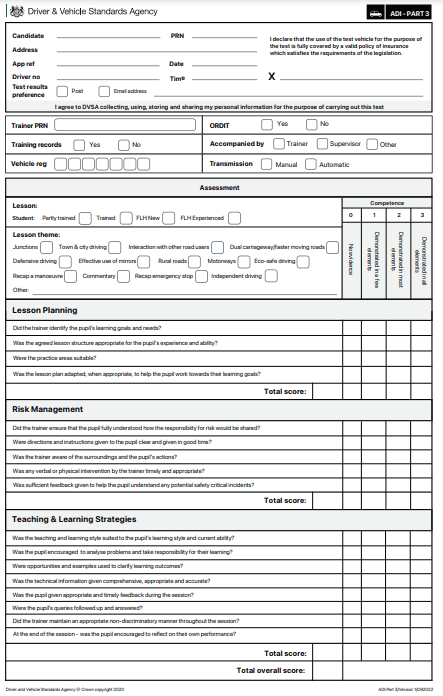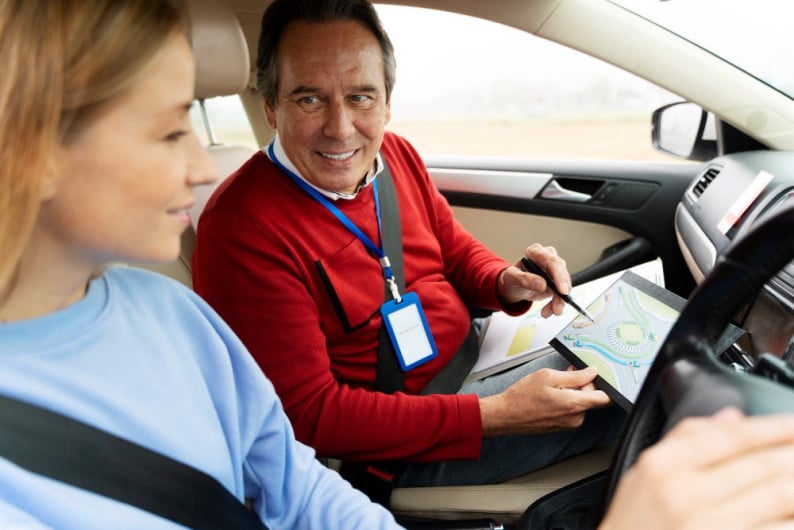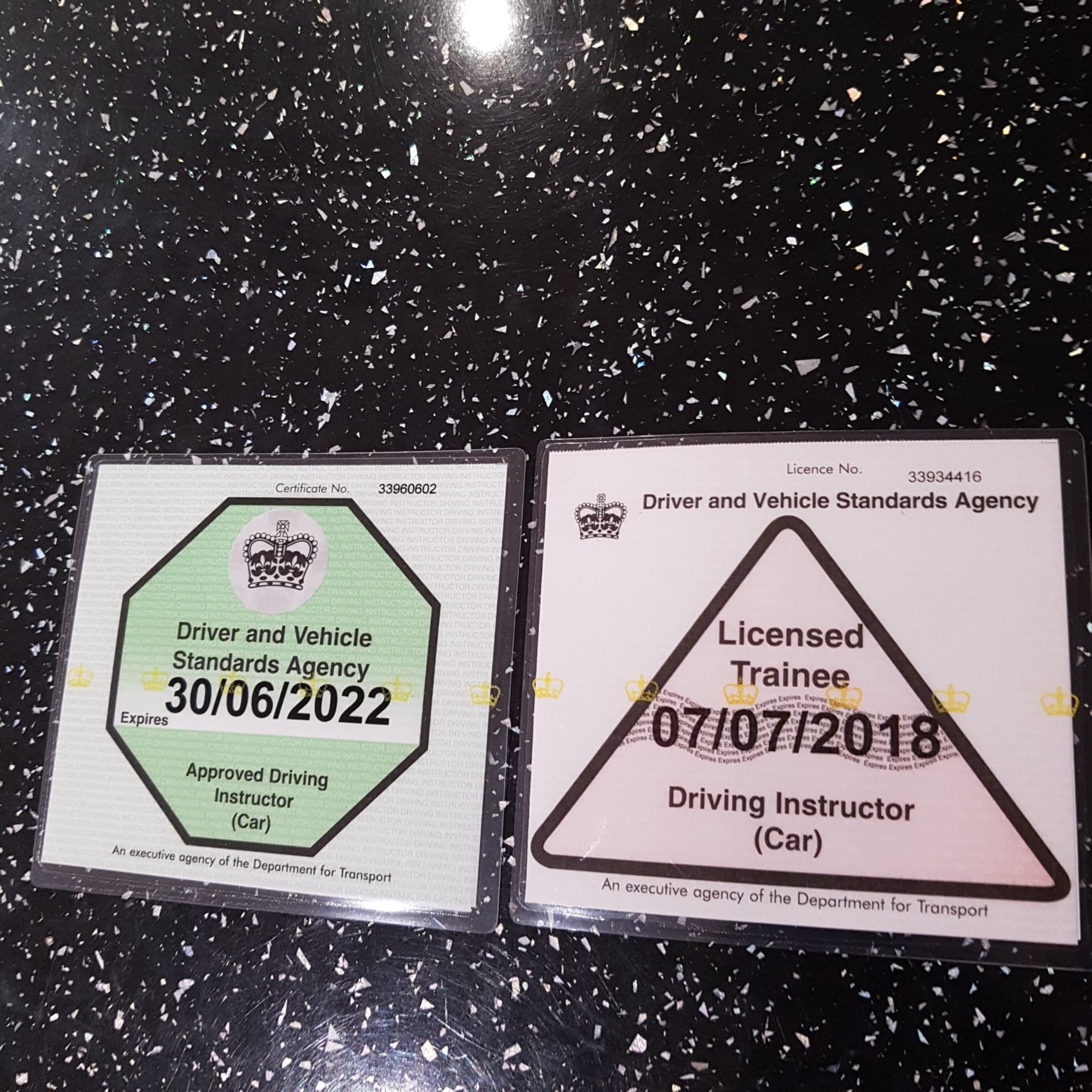Teaching and Learning Strategies
10. Was the teaching style suited to the pupil's learning style and current ability?
In reality it doesn't matter what subject you teach for your Part 3 or Standards check, what matter is that learning takes place.
If what you are doing is not engaging the pupil into learning something new, or what you are doing is just not working, then you need to change the lesson to something that will benefit the pupil and meet their needs at that time.
If the way you are teaching a particular subject isn't working you need to be able to adapt the style in which you are teaching it to something that allows the pupil to understand it. That might be that a demonstration is needed, or refer to books or videos etc so that the information can be understood and then worked with.
Is there something you can "link up" with your pupil to something they may have done in the past.
Lets just use a quick example.
Your pupil is a keen BMX rider, but during their lesson they are having trouble understanding how to make the car stop smoothly. They keep jamming on the brakes hard.
You could refer to what would happen if they squeezed the brake lever on the front of the BMX really hard at speed.
Their answer should be, "I'd be thrown off the bike over the handlebars, because the front wheel would lock up".
Now ask them, "how do you resolve that so it doesn't happen"?
The answer should be "I don't squeeze the lever as hard"
You could then say "so how could you resolve the issue with the cars brakes so that we don't screech to a stop"?
The reply should be "If I press the brake pedal more gently"
People generally have 4 different methods of how they learn best.
You need to know what best suits your pupil.
Most will have a combination of these 4 styles but more often than not they will have a predominant style of learning
Visual
Auditory
Reading & writing
Kinaesthetic
Commonly referred to as the VARK Model
Visual learners.
Prefer to take in information using charts, maps, graphs, diagrams, and more. Using images to explain concepts and ideas is the best way to reach a visual learner. However, this type of learning style does not include photographs or videos. Instead, visual learners learn best when information is presented using patterns, shapes, and other visual aids in the place of written or spoken words. One way teachers can differentiate their instruction for visual learners is by using graphic organizers to teach a lesson. A flow chart might be used to explain a scientific process, for example.
Auditory learners.
This learning style describes students who learn best when information is heard or spoken. They benefit from lectures, group discussion, and other strategies that involve talking things through. “Often people with this preference want to sort things out by speaking first, rather than sorting out their ideas and then speaking,” VARK Learn Limited explains. To help auditory learners learn, teachers can post audio recordings of lessons on the class website, or incorporate group activities that require students to explain concepts to their classmates.
Reading & writing learners.
Learners who have a reading/writing preference prefer information to be presented using words. They love to read and perform well on written assignments such as stories or book reports. “This preference emphasizes text-based input and output – reading and writing in all of its forms,” VARK Learn Limited notes. A great way to help these students learn is by having them describe diagrams or charts using written statements. Then, they can study their notes later to better retain the information.
Kinaesthetic learners.
Kinaesthetic learners learn best when they can use tactile experiences and carry out a physical activity to practice applying new information. “People who prefer this mode are connected to reality, ‘either through concrete personal experiences, examples, practice or simulation.
Give these students a working example of an idea or process, or task them with recreating experiments to illustrate concepts. Sometimes this is just a case of trial and error to find out what works and what doesn't.
Ensuring you give a client centered lesson should mean that you are making the lesson around your pupils needs and this should incorporate how they prefer to learn.
11. Was the pupil encouraged to analyse problems and take responsibility for their learning?
Did you give your pupil a chance to speak?
Did they have chance to analyse what happened, was it good bad or indifferent?
Could they distinguish where things were good and what made it good and could they work out why things maybe didn't go so well and understand what they could do differently to make it not happen again.
One of the biggest reasons why instructors get marked down in this subject is because they over instruct.
If you don't stop talking, how can you pupil analyse what they have just done?
Ask questions such as "How did that go?"
Learning tends to take place more if a pupil can take responsibility for their learning and analyse when things go wrong. Give them a chance to analyse faults. If they have no idea what may have gone wrong there is nothing wrong with you stepping in and assisting (it's what you are there for) but don't jump in straight away, allow them time to think over what happened, how they could change what they did, and how by changing things the result could be different. Then let them put that into practice.
Continue to ask questions such as " How could we do that differently next time?" & "What might we achieve by doing it that way instead?"
Find a way of helping them to understand how they rectified the issue so that it doesn't happen again. This might be by taking notes, watching a video at home as homework, reading a section of the Highway code. Whatever it may be, help them to find a way that they can process the information and instill a way of them taking responsibility for their learning.
12. Were opportunities and examples used to clarify learning outcomes?
Highlight the good drivers on the road, don't highlight the bad ones!
By getting your pupil to point out good drivers it reinforces learning the correct methods.
These good drivers are opportunities and examples to clarify their learning.
Get your pupil to express items that they have an understanding of and also a misunderstanding of.
Ask them if things made sense, give examples of real life situations where things may have gone right and likewise where they may have gone wrong and see if your example makes sense to them. Possibly get them to delve deeper into that particular example and ask them what they feel about it.
As with item 11, give your pupil time to think about their answers, don't just jump in and give them yours.
13. Was the technical information given comprehensive, appropriate and accurate?
This is a crucial subject!
The information you give to your pupil MUST BE ACCURATE! If you do not know the answer that's fine, we can't possibly know everything about everything.
But don't just guess and give an inaccurate answer. Explain to your pupil that at the moment you can't give them a concise answer to their query but to let them leave it with you and you will get back to them. And indeed GET BACK TO THEM.
Obviously, you'll be expected to know the most basic stuff like priorities, road signs, speed limits etc etc, but some more technical information may require a little investigation and that's ok, but just reassure your pupil you will find out the correct information and get back to them.
I've heard stories where pupils have been told if they need to use an emergency phone on a motorway it will cost them £200 just to pick the phone up!
I've heard others that it's illegal to carry out a U-turn on a mini roundabout! It's not advisable due to the limited space, but it's not illegal!
If you supply this sort of mis-information to your pupils they will take it as gospel because YOU are the professional!
Use language that the DVSA use as well, things like Dead End Road instead of No through Road is not good, it sets up a bad habit with your pupils to not know the true meaning of things. This overtime can get broken down even further and before you no it, that "Dead End" becomes a No Entry. It's a little like Chinese whispers, it just grows and grows.
Using good terminology and facts keeps the information comprehensive, appropriate and accurate.
14. Was the pupil given appropriate and timely feedback during the session?
When feedback needs to be given, ensure that it not too late.
There is no point commenting about something that happened five minutes ago, your pupil will probably have forgotten about it.
If it needs to be given then ensure it is given at the correct time. If it cannot be done on the move, ensure you highlight it there and then and then address it as soon as you can when it is safe to do so.
Appropriate feedback is not by saying things like "that was good"
What was good?
Elaborate!
"Excellent job with those mirror checks, that's much better than the last junction"
"Well done on reducing your speed before that tight bend"
"Great positioning in the road to allow you to see around the parked vehicle"
Even if it's not a good thing your pupil has done, you may still give appropriate feedback such as
"Good job with your rear view mirror check before slowing down, but was there another mirror we should have checked before turning left?"
"Did we need to signal to exit the roundabout?"
Make sure your pupil understands when things are good or bad but ensure it makes sense to them and is given in good time.
15. Were the pupils queries followed up and answered?
If your pupil asks a question, ensure that it is answered!
If it's not a suitable time to answer it then make a note and come back to it before the end of the lesson.
Try and ensure that whilst talking with your pupil that you look at them to read their body language. A look of confusion on their face can lead to you asking further questions to ensure they have fully understood what has been said or elaborate on the information so that it does make sense.
As with 13, if you are unsure of the answer to a question, definitely reply to your pupil that you will find the answer and get back to them.
16. Did the trainer maintain an appropriate non-discriminatory manner throughout the session?
This not only covers what is going on inside the car but also outside of the car!
Negative or derogatory comments about other drivers, their driving skills or techniques, the make of their car, their appearance, etc all are information that does not get shared with your pupil.
No subject, whatever your feeling are towards it should be remarked on. Cyclists,Horse riders, BMW's, White van drivers, someones size, how good looking someone may be or how ugly you think someone may be, it's your opinion and should remain in your head at all times.
Your pupil is your pupil, they are not your "flower, petal, darling, babe, mate, sweetie etc.
You refer to your pupil by their name or a name that they prefer to be referred to as.
It can be really stressful at times, especially with the current level of poor driving that we see on today's roads, but it is not your job to remark on someone else's bad driving. None of us are aware of the true circumstances or state of mind of another driver, and their reasoning for driving as they are, but there may actually be a justified reason as to why they have just overtaken 20 cars in a really dangerous manner.
It may be that they have a seriously ill child in the car and they are rushing to hospital. It's not be an excuse to the fact that they have put other drivers or pedestrians at risk by doing so, but in the here and now, the only thing that may be going through their mind is that they need to save that child's life.
There will be other drivers that are just not paying attention because someone may have just died in their family and their mind is somewhere else other than on driving and mistakes may be made.
Relationships cause people to do out of the norm driving, and likewise just people being overly happy can also cause they driving to become erratic.
For us, we just have to keep the situation safe and carry on without judgement.
17. At the end of the session, was the pupil encouraged to reflect on their own performance?
Set up the next part of their learning journey based on what they have progressed with today.
Get the pupil to reflect on how they did. Possibly by scaling them at where they felt they were at the start of the session and where they are at the end.
Find out what made their results better..... or worse, and how they can build their skills even further on the next session
Scaling works well from 1 -10
1 being really inexperienced and 10 being awesome
Irrelevant of where you think their score should be, it's their score in their mind of where they are. It's not for you to judge either way.
If you thought they were a 4 and they reckon they are an 8 that's fine!
Questions that then need to be asked are things like "Great an 8, so how can we turn that 8 into a 9?" or "What could we do differently to increase that score further?"
Likewise, if they scored themselves with a 4 and you thought what they had done deserved an 8, delve a little deeper with them as to why they felt a 4?
Still ask them what they feel they need to work on to make that score a 5 or 6, if there are only a couple of items that need rectifying, maybe you could consider praising them on spotting the things they need to rectify but also build them up a little saying something like " Based on the things you've told me that need rectifying, which I agree with you on, maybe you've been a little bit harsh on yourself and that because there are only a couple of tiny things to resolve maybe your initial score could have been a little higher? "How do you feel about that?"
They may say for now they want to keep the score as it is and work each week to build it up, which is great as it gives them a target to aim for.
Alternatively, they may feel that yes maybe they were a little harsh on themselves and that by breaking down what needed working on they've realised they are a bit better than they first thought.
This will do good for their self esteem, but whatever way they score themselves, it is not our job to say whether their score is right or wrong, it is their score not ours, our job is to get them to understand if more is required of a subject and coax the pupil in a way to see that they are on track or that additional improvement needs to be made.
Discuss with your pupil what they would like to look at on the next session and how they can incorporate what they learnt today into the next session.
The more feedback and reflection you can get out of the pupil the better.













